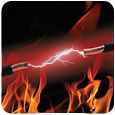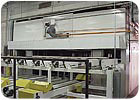Hybrid Convection Ovens: A Cure for the Common Energy Crunch?

A warm winter forecast and adequate natural gas supplies were supposed to keep natural gas prices in the U.S. in check, at least in the short term. Instead, natural gas prices have continued to be highly volatile, thanks to a bottleneck in storage and pipeline capacity. While businesses that have locked in their gas prices for a set period of time can breathe easy for now, most experts agree that energy costs will remain a challenge for the foreseeable future. As a result, the only reliable long-term strategy is to investigate flexible technologies that can accommodate multiple energy sources.
One idea being explored by several coating job shops is a hybrid convection oven that is under development through a partnership between the Tennessee Valley Authority (TVA), America’s largest public power company, and Fostoria Industries, Inc., Fostoria, OH, a company that designs and manufactures industrial heating equipment.
“We are working with a few plants in the finishing industry to see if they can take an existing gas convection oven and add electric components within it to give them the flexibility of switching between fuels based on energy prices,” explains Sara Madugula, TVA industrial marketing manager. “This approach can help customers budget their monthly operational costs and can give them some control over their energy expenses. The additional electric equipment can be installed with no need for extra floor space, which is another plus.”
System Modifications
According to Bob Stroman, Midwest district sales manager and application engineer for Fostoria Industries, the hybrid system typically involves installing an electric duct heater in the convection oven in-line with the existing gas burner. An additional control panel is also required to control the electric duct heater when it’s in use. The existing recirculation system, including the fan and ductwork, is reused. In some cases, an adjustable damper is added to the exhaust system to reduce the exhaust when the oven is running on electricity. (Electric operation requires less exhaust than gas, so cutting back on the exhaust during electric operation can improve the oven’s efficiency.)While the investment in such a project can be substantial - anywhere from $50,000 to $100,000 or more, depending on the specific modifications required - the payback can occur rapidly, especially when the local utility is willing to help out. For example, during a recent period of high natural gas price volatility, one coating job shop that was paying $13/million BTU for natural gas discovered that it could save more than $123,000 per year through credits offered by TVA for switching to electricity. While the proposed equipment modifications totaled more than $80,000, the anticipated payback in this case would occur in less than one year.
For many finishing operations, the ability to accurately budget monthly energy costs can be particularly appealing. “A customer can say that they want to spend no more than $200,000 this month on energy to operate a certain oven. The customer knows what the electric and gas rates are. They know that when gas climbs to a certain price, it is no longer cheaper to run on gas. With the hybrid system, they can switch to electricity to hold their total costs down, and vice versa,” explains Madugula.
According to Madugula, the hybrid technology can benefit both the utilities and their customers because the customer’s oven would be capable of switching from electric to gas during peak electricity demand periods, when power production costs are often the highest.
“When the load on the TVA power system peaks - typically in the summer months when everyone is running their air conditioning - we can rely on customers with hybrid systems to shift to gas and thereby help TVA avoid buying additional electricity on the open market at high rates. Since gas is usually cheaper in the summer, this is a win-win situation for everyone,” she says.

The hybrid system typically involves installing an electric duct heater in the convection oven in-line with the existing gas burner.
A Creative Approach
The “dual-fuel” concept isn’t new. Hybrid infrared (IR)/convection ovens, which typically involve installing an IR booster inside a convection oven, have been implemented by a number of finishing operations to provide energy savings, increase line speeds and improve finish quality. According to Stroman, such systems can have a more far-reaching impact than the simple electric/convection hybrid. However, not all processes are conducive to IR heat. For these operations, and for operations where gas prices are particularly high or unstable, the electric/hybrid system might be a viable way to save on energy costs.Stroman notes that the technology also can provide a backup energy source that can prevent downtime if an interruption occurs in either system. However, he is quick to point out that the electric/convection hybrid is not a panacea.
“Equipment suppliers and utilities such as TVA are continuously working to find creative ways to help finishing professionals cope with the problem of skyrocketing energy costs. The electric/convection hybrid is just one possible solution,” he says. “Plants should work closely with equipment suppliers and their local utility to determine what might work best in their particular situation.”
For more information about TVA, call 615.232.6815 or visit www.tva.gov. For more information about Fostoria Industries, call 800.495.4525 or 419.435.9201, e-mail email@fostoriaindustries.com or visit www.fostoriaindustries.com.
Links
Looking for a reprint of this article?
From high-res PDFs to custom plaques, order your copy today!



